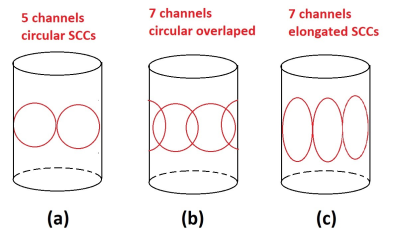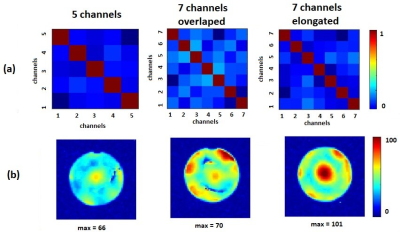1449
Shielded-coaxial-cable (SCC) coils - the array configuration for maximized central SNR at 7T MRI1Section for Magnetic Resonance, DTU Health Tech, Technical University of Denmark, Copenhagen, Denmark, 2Danish Research Centre for Magnetic Resonance, Centre for Functional and Diagnostic Imaging and Research, Copenhagen University Hospital Amager and Hvidovre, Copenhagen, Denmark, 3Electrical Engineering Department, Technical University of Eindhoven, Eindhoven, Netherlands
Synopsis
The shielded-coaxial-cable (SCC) coils have been proposed recently as highly decoupled elements per se. The SCC coils are not very sensitive to bending, elongation and various degrees of overlapping. We experimentally investigated the central SNR when the SCC coils are placed in three different arrangements on a cylindrical object. The highest central SNR (more than 30% higher than in the other two arrangements) was obtained when the coils were elongated and adjacent to each other. This arrangement is important when the ROI is located deep inside the field of view, such in c-spine spinal cord or deep brain imaging.
Introduction
The SCC coils have been recently proposed as a highly decoupled elements per se (no need for additional decoupling) and as convenient elements to be used in an array configuration1,2. Besides advantageous decoupling properties compared to the conventional coil, the SCC coil is much less sensitive to the geometry changes – bending, elongation and overlap. Several arrays have been built (for a knee, hand and neck imaging) and their functioning have been demonstrated in in-vivo measurements1-4. Partial overlapping or elongation does not de-tune SCC coils significantly, while the interelement coupling stays at the accepting level. For some applications, such as imaging of c-spine spinal cord or deep brain imaging, due to the position of the region of interest, it is important to understand which coil arrangement on a cylindrical object provides the best central SNR. In this abstract, we are experimentally investigating the SNR in a central region for three different SCC coil arrangements.Methods
The coils were fabricated of coaxial cable (Habia Cable RG 316) with the pi matching network and capacitors soldered on an FR4 pcb board. Due to the flexibility of coaxial cable and non-sensitivity to the elongation, the same fabricated coils were made round (circular) and elongated (Figure 1). Cylindrical phantom used in measurements was 200 mm long and with 150 mm diameter. The phantom was filled in with the water-salt solution (4g/l of NaCl). Three coil arrangements were investigated (Figure 2): 5 circular coils adjacent to each other (no overlap), 7 circular coils with high degree of overlap (~35%) and 7 elongated coils adjacent to each other (no overlap). The coils were placed on a same cylindrical phantom. The B1+ field phase shimming has been performed for the maximum field at the center of phantom. The SNR was measured with a gradient echo sequence (TE/TR=1/500 ms, FA=1o, voxel size 3.5x3.5x3.5 mm3) and then corrected for the B1+ field. The noise was calculated from a second gradient echo image with 0 degree flip angle. B1+ field was obtained with DREAM sequence5, also with 3.5mm isotropic resolution.Results
Figure 3 (a) shows noise correlation matrices. The coils were sufficiently decoupled in all the three arrangements. Figure 3 (b) shows measured central SNR. The maximum central SNR of the 5-channel circular arrangement was 66, while the maximum central SNR of 7-channel circular overlapped array was 70. The maximum central SNR of 7-channel elongated coils array was 101. The central SNR of 7-channel elongated coils was more than 30% higher than the other two configurations.Discussion
In this abstract, we experimentally investigated dependence of the central SNR on different SCC coils configurations, with coils placed on a cylindrical phantom. In our work, 5-channel circular non-overlapped SCC coil array shows slightly lower central SNR compared to 7-channel array of highly overlapped circular SCC coils. The highest central SNR (more than 30% higher than the other two examined configurations) was obtained with the 7-channel array of adjacent elongated SCC coils. This result suggests us that this SCC coil configuration is the best to be use for imaging of deep regions. Similar study has been performed for conventional coils in three configurations – 10% (optimal) overlap, 40% overlap (over-overlap) and 10% of overlap of elongated coils and for three different coil sizes (50mm, 70mm and 90mm diameter)6. The simulation results obtained do not show increase of the central SNR at 7T for any coil configuration and for any coil size6. In6, the problem was to practically realize the setups due to the decoupling problem of conventional coils when placed in an array configuration and when the degree of overlap is different than optimal. We demonstrated high interelement decoupling of SCC coils also with high degree of overlap. Comparing the SCC and conventional coils - the conventional coils are sensitive to the elongation, so it might be that the properties of the conventional coils degrade when elongated, while the SCC coil still efficiently operates. This suggests that, at some applications, the use of SCC coils is advantageous over the conventional coils, not only from the decoupling but also from the performance aspect.Conclusions
In applications where the coils are arranged on approximately cylindrical surface (on cylindrical holder) and the region of interest is in depth, it is important to optimally place the coils to produce the highest central SNR. It is shown that the same number of elongated SCC coils produces the superior central SNR (more than 30% higher) compared to the highly overlapped circular SCC coils and non-overlapped circular SCC coils. Future work will also investigate other characteristics of the proposed configurations, such as g-factor and capabilities of achieving high accelerations.Acknowledgements
No acknowledgement found.References
1. Ruytenberg T, Webb A, Zivkovic I. Shielded‐coaxial‐cable Coils as Receive and Transceive Array Elements for 7T Human MRI. Magn Reson Med. 2019; 83(3):1135–1146.
2. Ruytenberg T, Webb A, Zivkovic I. A Flexible Five‐channel Shielded‐coaxial‐cable (SCC) Transceive Neck Coil for High‐resolution Carotid Imaging at 7T. Magn Reson Med. 2020; 84(3):1672–1677.
3. Zivkovic I, Ruytenberg T, Webb A. A five channel transcieve array with shielded coaxial loop coils for laryngeal imaging at 7T. ESMRMB 2017; 30(Supplement 1) S50-S51.
4. Ercan E, Ruytenberg T, O’Grady KP, Smith SA, Webb A, Zivkovic I. A multi-element transceive array for cervical spinal cord imaging at 7T. ISMRM 2020 Online conference.
5. Nehrke K, Bornert P. DREAM - a novel approach for robust, ultrafast, multislice B-1 mapping. Magn Reson Med. 2012; 68: 1517– 1526.
6. Ming L, John CG, Xinqiang Y. Over-overlapped loop arrays: A numerical study. Magn Reson Imag. 2020;72:135-142.
Figures


